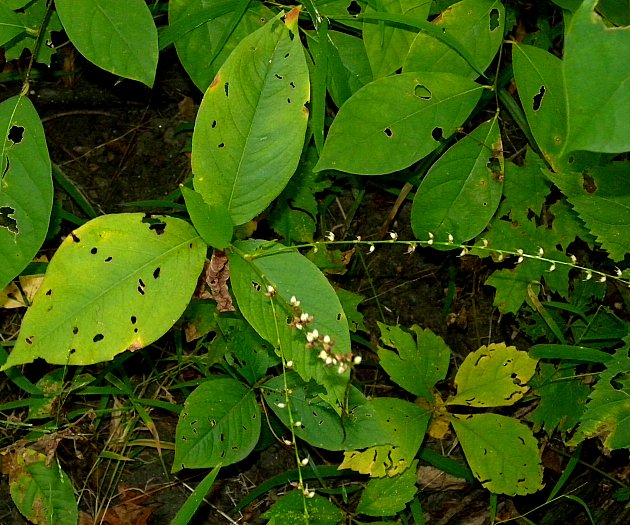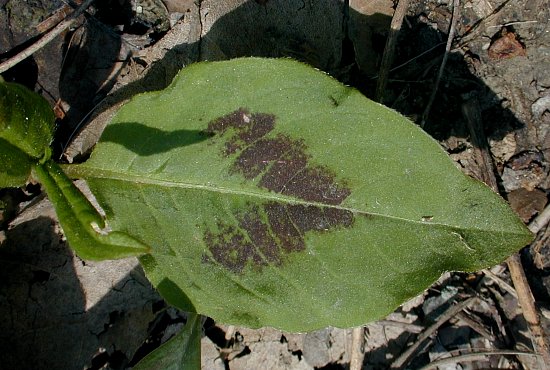Jumpseed
Antenoron virginianum
Knotweed family (Polygonaceae)
Antenoron virginianum
Knotweed family (Polygonaceae)
Description:
This perennial herbaceous plant becomes 1–2' (0.3–0.6 m.) tall (not
including the inflorescence), usually consisting of a single unbranched
stem with alternate leaves. The central stem is light green, terete,
and glabrous to short-pubescent. Individual leaves are up to 6" (15
cm.) long and 3½" across (9 cm.); they are ovate in shape, toothless,
and short-ciliate along their margins. The upper leaf surface is light
green to medium-dark green and glabrous to short-pubescent, while the
lower leaf surface is light green and hairy primarily along the veins.
Vernal leaves of this plant also have rather fuzzy chevrons (one
chevron per leaf) on their upper surfaces that are dark reddish-purple.
Leaf venation is pinnate. The petioles of the leaves are ¼–¾"
(6–18 mm.) in length, light green, and glabrous to short-pubescent. At
the base of each petiole, there is a brown-membranous ochrea
(sheath-like structure) that wraps around the stem. The ochreae are
glabrous to pubescent and long-ciliate along their upper margins. The
inflorescence consists of 1–2 terminal spike-like racemes and 0–2
axillary spike-like racemes of flowers; the latter, if present, develop
from the axils of the uppermost leaves. These slender racemes are up to
16" (0.4 m.) in length and, relative to the ground, they are erect,
ascending, or horizontal. Flowers with short pedicels up to 2 mm. long
are sparsely distributed along the central stalk of each raceme
(although they become more crowded toward the apex).

Individual flowers are about 3–4 mm. across when they are fully open; each flower has a white calyx consisting of 4 triangular-ovate sepals, 4–5 stamens with white filaments and white to pale yellow anthers, and a pair of white conjoined styles with hooked tips. At the base of each pedicel, there is a short transparent-membranous ocreola (sheath-like structure) that wraps around the stem. The ochreolae are glabrous to pubescent and they are usually ciliate along their upper margins. The blooming period occurs from mid-summer to early autumn, lasting about 2 months for a colony of plants. The flowers bloom gradually from the bottom to the top of each raceme. Afterwards, the flowers are replaced by achenes (one achene per flower). These achenes are about 3.5–4 mm. long, 2–2.5 mm. across, dark brown to black, and ovoid-biconvex in shape. The achenes can be distributed several feet from a mother plant by mechanical ejection. The root system is fibrous and rhizomatous. Clonal plants are often formed by the rhizomes.
Cultivation: The preference is partial sun to medium shade, moist to dry-mesic conditions, and rich loamy soil, although clay-loam and other kinds of soil are tolerated. Most growth and develop occurs during the spring and summer.
Range & Habitat: The native Jumpseed (Antenoron virginianum) is a common plant that occurs throughout Illinois (see Distribution Map). This plant is widely distributed in the eastern one-half of the United States. Typical habitats include upland deciduous woodlands, lowland deciduous woodlands, woodland edges, thickets, and edges of gravelly seeps. This native plant tends to be more common in woodlands with a history of disturbance.

Faunal Associations: The nectar of the flowers attract honeybees, bumblebees, leaf-cutting bees (Megachile spp.), Halictid bees (including green metallic bees), Sphecid wasps, Eumenine wasps, and ants (Wilhelm & Rericha, 2017). The ants are nectar thieves and non-pollinating. Insects that feed destructively on the plant juices of Jumpseed (Antenoron virginianum) include the Dusky Stink Bug (Euschistus tristigmus) and a leafhopper (Erasmoneura nigra); see Rider (2009) and Dmitriev & Dietrich (2010). Many insects that feed on smartweeds (Persicaria spp.) and knotweeds (Polygonum spp.) probably feed on this plant too. The foliage of Jumpseed is rarely browsed by White-tailed Deer (Frankland & Nelson, 1999).
Photographic Location: Busey Woods in Urbana, Illinois, and along a fence row of the webmaster's apartment complex in the same city.
Comments: Jumpseed (Antenoron virginianum) has a history of taxonomic instability – scientific synonyms include Polygonum virginianum, Persicaria virginiana, and Tovara virginiana. Sometimes this plant is referred to as Woodland Knotweed or Woodland Smartweed. It is relatively easy to distinguish this plant from the similar smartweeds (Persicaria spp.) because of its long spike-like racemes along which the flowers are sparsely distributed. Its flowers also have only 4 petaloid sepals, rather than the 5 petaloid sepals that are typical of true smartweeds. Jumpseed also has a strong preference for shaded habitats, while smartweeds are usually, but not always, found in sunny wetlands.

Individual flowers are about 3–4 mm. across when they are fully open; each flower has a white calyx consisting of 4 triangular-ovate sepals, 4–5 stamens with white filaments and white to pale yellow anthers, and a pair of white conjoined styles with hooked tips. At the base of each pedicel, there is a short transparent-membranous ocreola (sheath-like structure) that wraps around the stem. The ochreolae are glabrous to pubescent and they are usually ciliate along their upper margins. The blooming period occurs from mid-summer to early autumn, lasting about 2 months for a colony of plants. The flowers bloom gradually from the bottom to the top of each raceme. Afterwards, the flowers are replaced by achenes (one achene per flower). These achenes are about 3.5–4 mm. long, 2–2.5 mm. across, dark brown to black, and ovoid-biconvex in shape. The achenes can be distributed several feet from a mother plant by mechanical ejection. The root system is fibrous and rhizomatous. Clonal plants are often formed by the rhizomes.
Cultivation: The preference is partial sun to medium shade, moist to dry-mesic conditions, and rich loamy soil, although clay-loam and other kinds of soil are tolerated. Most growth and develop occurs during the spring and summer.
Range & Habitat: The native Jumpseed (Antenoron virginianum) is a common plant that occurs throughout Illinois (see Distribution Map). This plant is widely distributed in the eastern one-half of the United States. Typical habitats include upland deciduous woodlands, lowland deciduous woodlands, woodland edges, thickets, and edges of gravelly seeps. This native plant tends to be more common in woodlands with a history of disturbance.

Faunal Associations: The nectar of the flowers attract honeybees, bumblebees, leaf-cutting bees (Megachile spp.), Halictid bees (including green metallic bees), Sphecid wasps, Eumenine wasps, and ants (Wilhelm & Rericha, 2017). The ants are nectar thieves and non-pollinating. Insects that feed destructively on the plant juices of Jumpseed (Antenoron virginianum) include the Dusky Stink Bug (Euschistus tristigmus) and a leafhopper (Erasmoneura nigra); see Rider (2009) and Dmitriev & Dietrich (2010). Many insects that feed on smartweeds (Persicaria spp.) and knotweeds (Polygonum spp.) probably feed on this plant too. The foliage of Jumpseed is rarely browsed by White-tailed Deer (Frankland & Nelson, 1999).
Photographic Location: Busey Woods in Urbana, Illinois, and along a fence row of the webmaster's apartment complex in the same city.
Comments: Jumpseed (Antenoron virginianum) has a history of taxonomic instability – scientific synonyms include Polygonum virginianum, Persicaria virginiana, and Tovara virginiana. Sometimes this plant is referred to as Woodland Knotweed or Woodland Smartweed. It is relatively easy to distinguish this plant from the similar smartweeds (Persicaria spp.) because of its long spike-like racemes along which the flowers are sparsely distributed. Its flowers also have only 4 petaloid sepals, rather than the 5 petaloid sepals that are typical of true smartweeds. Jumpseed also has a strong preference for shaded habitats, while smartweeds are usually, but not always, found in sunny wetlands.